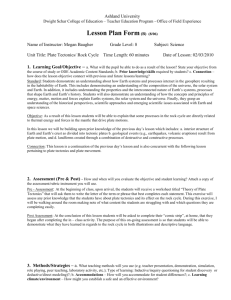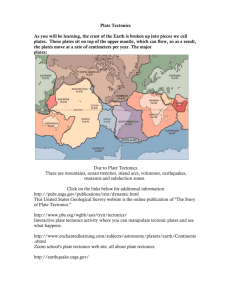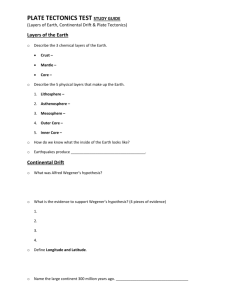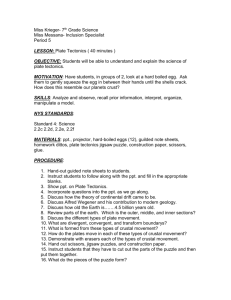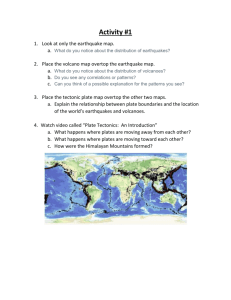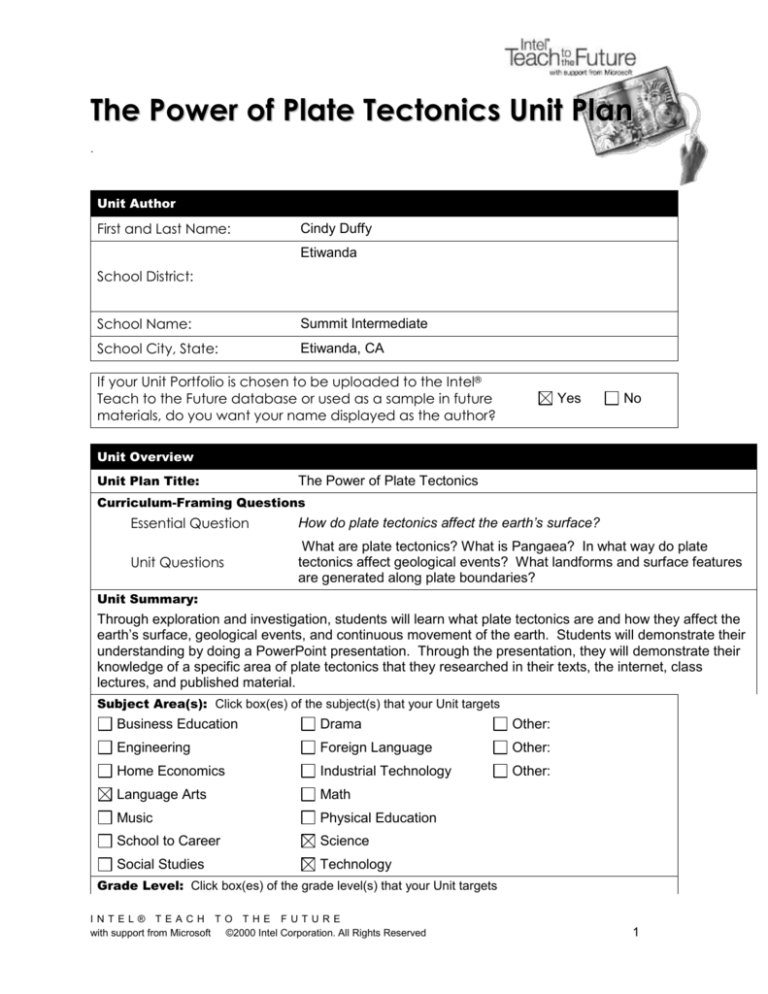
The Power of Plate Tectonics Unit Plan
.
Unit Author
First and Last Name:
Cindy Duffy
Etiwanda
School District:
School Name:
Summit Intermediate
School City, State:
Etiwanda, CA
If your Unit Portfolio is chosen to be uploaded to the Intel®
Teach to the Future database or used as a sample in future
materials, do you want your name displayed as the author?
Yes
No
Unit Overview
Unit Plan Title:
The Power of Plate Tectonics
Curriculum-Framing Questions
Essential Question
How do plate tectonics affect the earth’s surface?
Unit Questions
What are plate tectonics? What is Pangaea? In what way do plate
tectonics affect geological events? What landforms and surface features
are generated along plate boundaries?
Unit Summary:
Through exploration and investigation, students will learn what plate tectonics are and how they affect the
earth’s surface, geological events, and continuous movement of the earth. Students will demonstrate their
understanding by doing a PowerPoint presentation. Through the presentation, they will demonstrate their
knowledge of a specific area of plate tectonics that they researched in their texts, the internet, class
lectures, and published material.
Subject Area(s): Click box(es) of the subject(s) that your Unit targets
Business Education
Drama
Other:
Engineering
Foreign Language
Other:
Home Economics
Industrial Technology
Other:
Language Arts
Math
Music
Physical Education
School to Career
Science
Social Studies
Technology
Grade Level: Click box(es) of the grade level(s) that your Unit targets
INTEL® TEACH TO THE FUTURE
with support from Microsoft ©2000 Intel Corporation. All Rights Reserved
1
K-2
3-5
6-8
9-12
ESL
Resource
Gifted and Talented
Other:
INTEL® TEACH TO THE FUTURE
with support from Microsoft ©2000 Intel Corporation. All Rights Reserved
2
Targeted State Frameworks/Content Standards/Benchmarks:
Heat (Thermal Energy) (Physical Science)
3. Heat moves in a predictable flow from warmer objects to cooler objects until all the objects
are at the same temperature. As a basis for understanding this concept:
a. Students know energy can be carried from one place to another by heat flow or by waves,
including water, light and sound waves, or by moving objects.
b. Students know that when fuel is consumed, most of the energy released becomes heat
energy.
c. Students know heat flows in solids by conduction (which involves no flow of matter) and in
fluids by conduction and by convection (which involves flow of matter).
d. Students know heat energy is also transferred between objects by radiation (radiation can
travel through space).
Energy in the Earth System
4. Many phenomena on Earth's surface are affected by the transfer of energy through radiation
and convection currents. As a basis for understanding this concept:
a. Students know the sun is the major source of energy for phenomena on Earth's surface; it
powers winds, ocean currents, and the water cycle.
b. Students know solar energy reaches Earth through radiation, mostly in the form of visible
light.
c. Students know heat from Earth's interior reaches the surface primarily through convection.
d. Students know convection currents distribute heat in the atmosphere and oceans.
e. Students know differences in pressure, heat, air movement, and humidity result in changes of
weather.
Student Objectives/Learning Outcomes:
Each student will complete a PowerPoint presentation on an area of plate tectonics.
Through this unit, students will refine skills in the following areas:
- research (library and online)
- report writing
- using technology as a practical tool for research presentation and communication
Procedures:
1. Introduce plate tectonics with Bill Nye video; Spinning Things/Earthquakes . Discuss.
2. Read and discuss class text chapter on plate tectonics; Glencoe Science Voyages
Earth Science Chapter 9.
3. Students select a specific area related to plate tectonics.
4. Students begin teacher guided and independent research using the following
resources:
INTEL® TEACH TO THE FUTURE
with support from Microsoft ©2000 Intel Corporation. All Rights Reserved
3
-Library: informational books and magazines
-Classroom: encyclopedias
-Online: age-appropriate websites
5. Facts and notes will be written in students’ science journals. Teacher will collect and
check on them periodically.
6. After all facts are gathered, students will create a storyboard in preparation for
completing their PowerPoint presentation.
7.
Students will create an “outline” version of PowerPoint slides.
8.
Students will add background, graphics, clipart, sound files, and transitions.
9. Each student will present their final PowerPoint to their peers and teacher for
evaluation.
Approximate Time Needed:
12 50-minute periods
Prerequisite Skills:
1. Basic knowledge of computer keyboarding skills.
2. MS Word toolbars, basic word processing skills.
3. How to type information into a Word document.
4. How to save work to a floppy disk.
Materials and Resources Required For Unit
Technology – Hardware: (Click boxes of all equipment needed)
Camera
Laser Disk
VCR
Computer(s)
Printer
Video Camera
Digital Camera
Projection System
Video Conferencing Equip.
DVD Player
Scanner
Other:
Internet Connection
Television
Technology – Software: (Click boxes of all software needed.)
Database/Spreadsheet
Image Processing
Web Page Development
Desktop Publishing
Internet Web Browser
Word Processing
E-mail Software
Multimedia
Other:
Encyclopedia on CD-ROM
Glencoe, Science Voyages Earth Science Chapter 9
Printed Materials:
Class set of encyclopedias and dictionaries
Informational books written middle school students.
INTEL® TEACH TO THE FUTURE
with support from Microsoft ©2000 Intel Corporation. All Rights Reserved
4
Video: Bill Nye the Science Guy in Spinning
Things/Earthquakes Disney Education Production, IL 1998
Supplies:
Television and VCR
Science Journals
Floppy disks
http//www.google.com
http://www.pubsusgs.gov
http://www.pangaeafossils.com
Internet Resources:
http://www.newton.mec.edu
http://www.yahooligans.com
http://www.scholastic.com
Others:
Parents who are willing to present to the class as an expert in
a field relating to plate tectonics.
Accommodations for Differentiated Instruction
Resource Student:
Non-Native English
Speaker:
Gifted Student:
Make modifications as dictated in the students’ IEPs
Shorten assignments to core elements
Deliver instruction in a variety of ways, and present
models of acceptable work when possible.
Provide extra time for completing assignments
Enlist help from resource teacher
Provide intermediary checkpoints throughout the duration
of the unit
Encourage support from common language speakers who
are more proficient in English
Provide extra time for completing assignments
Use visuals, manipulatives and illustrated text when
possible
Small group instruction from teacher
Support deeper and more extensive study and
outcomes
Encourage students to pursue related topics of interest
in independent projects
Page 5 of 6
Assessments will include the following:
1. Evaluation of students’ notes in science journals.
Student Assessment:
2. Rubric for PowerPoint
3. Peer review questions at the end of each student
PowerPoint.
1. Alfred Wegner
2. conduction
3. convection
4. faults
Key Word Search:
5. fissures
6. lithosphere
7. mantle
8. mid-ocean ridge
9. Pangaea
10. plate tectonics
Page 6 of 6





